Macroeconomics Assignment Analysis: Business Economics BUECO5903
VerifiedAdded on 2022/10/02
|19
|1760
|33
Homework Assignment
AI Summary
This document presents a comprehensive analysis of macroeconomic principles, addressing key concepts such as absolute and comparative advantage, terms of trade, and various economic shocks. It includes an overview of the current state of the Australian economy, examining inflation, unemployment, and economic growth trends, supported by relevant figures. The assignment further explores the differences between Classical and Keynesian models, illustrating their responses to changes in aggregate demand. It then delves into the impacts of specific economic events, such as changes in oil prices, government spending, currency depreciation, and tax adjustments, on aggregate demand, supply, and overall economic activity, supported by diagrams. Finally, it examines the effects of interest rate changes, private domestic spending, goods and services tax, currency appreciation, and real estate price fluctuations, providing a thorough understanding of macroeconomic dynamics.
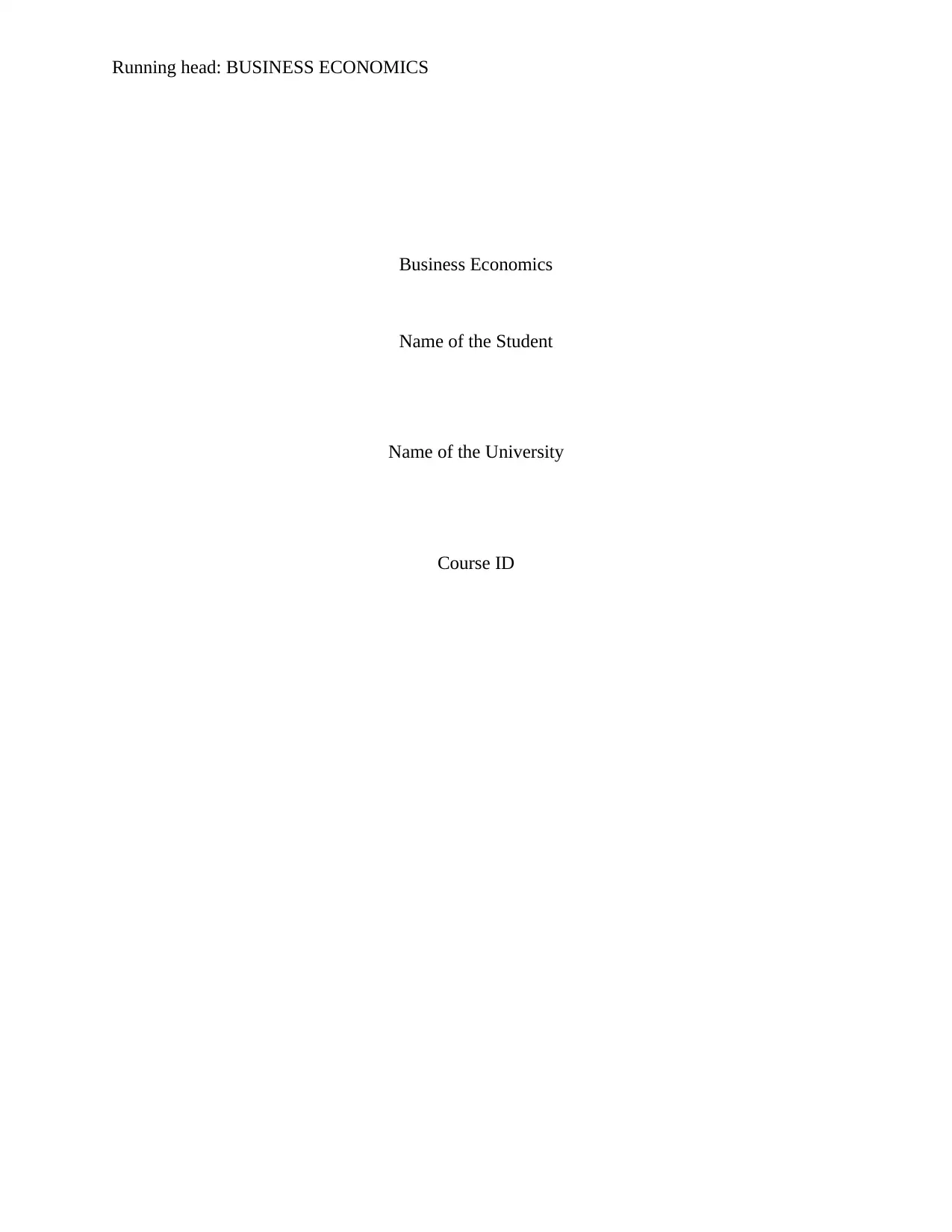
Running head: BUSINESS ECONOMICS
Business Economics
Name of the Student
Name of the University
Course ID
Business Economics
Name of the Student
Name of the University
Course ID
Paraphrase This Document
Need a fresh take? Get an instant paraphrase of this document with our AI Paraphraser

1BUSINESS ECONOMICS
Table of Contents
Question 2........................................................................................................................................2
Absolute advantage and comparative advantage.........................................................................2
Terms of trade and exchange rate................................................................................................2
A demand side shock and a supply side shock............................................................................2
A trade surplus and a budget surplus...........................................................................................2
Question 3........................................................................................................................................3
Current state of Australian economy...........................................................................................3
Question 4........................................................................................................................................7
Question 5........................................................................................................................................9
Question a....................................................................................................................................9
Question b..................................................................................................................................10
Question c..................................................................................................................................10
Question d..................................................................................................................................11
Question e..................................................................................................................................12
Question 7......................................................................................................................................12
Question a..................................................................................................................................12
Question b..................................................................................................................................13
Question c..................................................................................................................................14
Question d..................................................................................................................................14
Question e..................................................................................................................................15
References......................................................................................................................................16
Table of Contents
Question 2........................................................................................................................................2
Absolute advantage and comparative advantage.........................................................................2
Terms of trade and exchange rate................................................................................................2
A demand side shock and a supply side shock............................................................................2
A trade surplus and a budget surplus...........................................................................................2
Question 3........................................................................................................................................3
Current state of Australian economy...........................................................................................3
Question 4........................................................................................................................................7
Question 5........................................................................................................................................9
Question a....................................................................................................................................9
Question b..................................................................................................................................10
Question c..................................................................................................................................10
Question d..................................................................................................................................11
Question e..................................................................................................................................12
Question 7......................................................................................................................................12
Question a..................................................................................................................................12
Question b..................................................................................................................................13
Question c..................................................................................................................................14
Question d..................................................................................................................................14
Question e..................................................................................................................................15
References......................................................................................................................................16
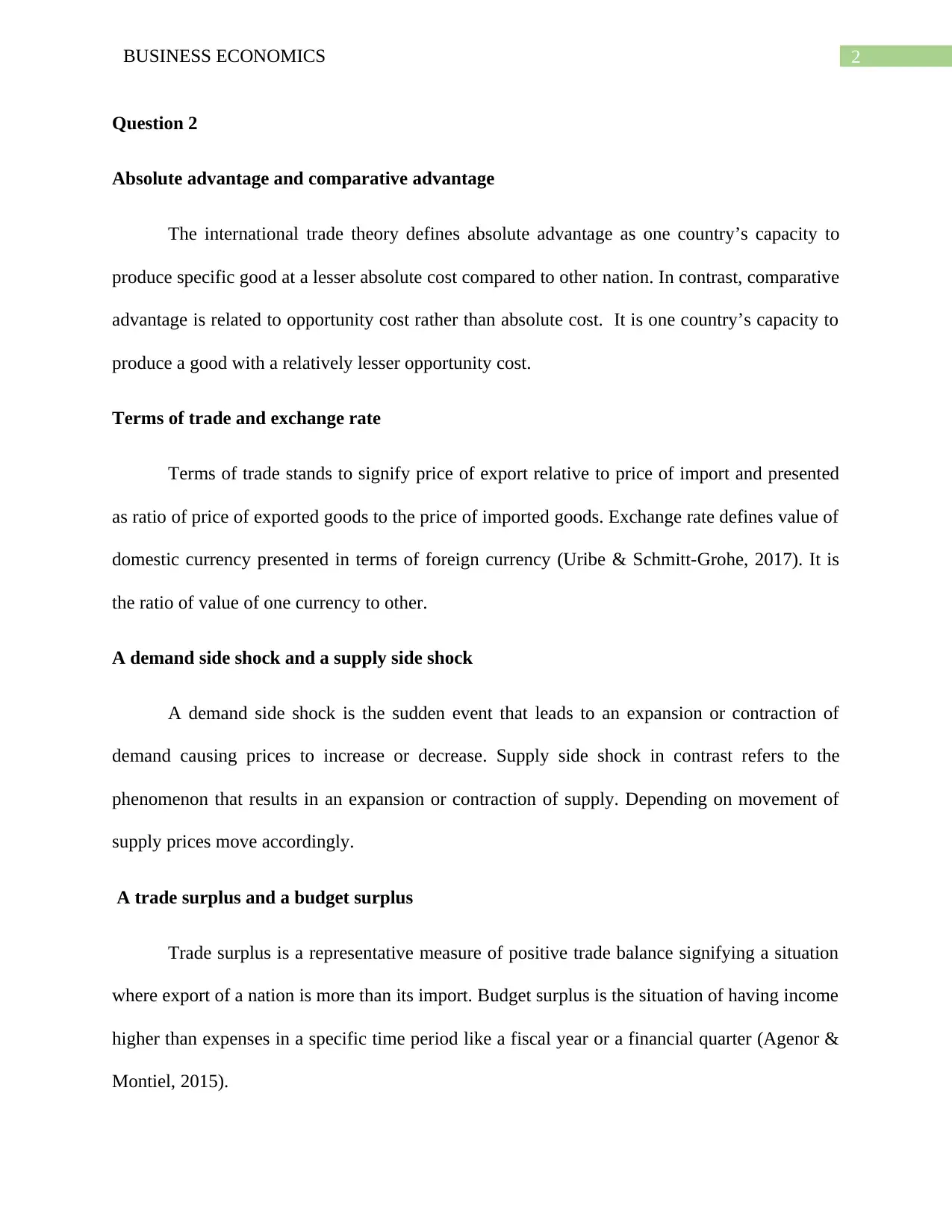
2BUSINESS ECONOMICS
Question 2
Absolute advantage and comparative advantage
The international trade theory defines absolute advantage as one country’s capacity to
produce specific good at a lesser absolute cost compared to other nation. In contrast, comparative
advantage is related to opportunity cost rather than absolute cost. It is one country’s capacity to
produce a good with a relatively lesser opportunity cost.
Terms of trade and exchange rate
Terms of trade stands to signify price of export relative to price of import and presented
as ratio of price of exported goods to the price of imported goods. Exchange rate defines value of
domestic currency presented in terms of foreign currency (Uribe & Schmitt-Grohe, 2017). It is
the ratio of value of one currency to other.
A demand side shock and a supply side shock
A demand side shock is the sudden event that leads to an expansion or contraction of
demand causing prices to increase or decrease. Supply side shock in contrast refers to the
phenomenon that results in an expansion or contraction of supply. Depending on movement of
supply prices move accordingly.
A trade surplus and a budget surplus
Trade surplus is a representative measure of positive trade balance signifying a situation
where export of a nation is more than its import. Budget surplus is the situation of having income
higher than expenses in a specific time period like a fiscal year or a financial quarter (Agenor &
Montiel, 2015).
Question 2
Absolute advantage and comparative advantage
The international trade theory defines absolute advantage as one country’s capacity to
produce specific good at a lesser absolute cost compared to other nation. In contrast, comparative
advantage is related to opportunity cost rather than absolute cost. It is one country’s capacity to
produce a good with a relatively lesser opportunity cost.
Terms of trade and exchange rate
Terms of trade stands to signify price of export relative to price of import and presented
as ratio of price of exported goods to the price of imported goods. Exchange rate defines value of
domestic currency presented in terms of foreign currency (Uribe & Schmitt-Grohe, 2017). It is
the ratio of value of one currency to other.
A demand side shock and a supply side shock
A demand side shock is the sudden event that leads to an expansion or contraction of
demand causing prices to increase or decrease. Supply side shock in contrast refers to the
phenomenon that results in an expansion or contraction of supply. Depending on movement of
supply prices move accordingly.
A trade surplus and a budget surplus
Trade surplus is a representative measure of positive trade balance signifying a situation
where export of a nation is more than its import. Budget surplus is the situation of having income
higher than expenses in a specific time period like a fiscal year or a financial quarter (Agenor &
Montiel, 2015).
⊘ This is a preview!⊘
Do you want full access?
Subscribe today to unlock all pages.

Trusted by 1+ million students worldwide
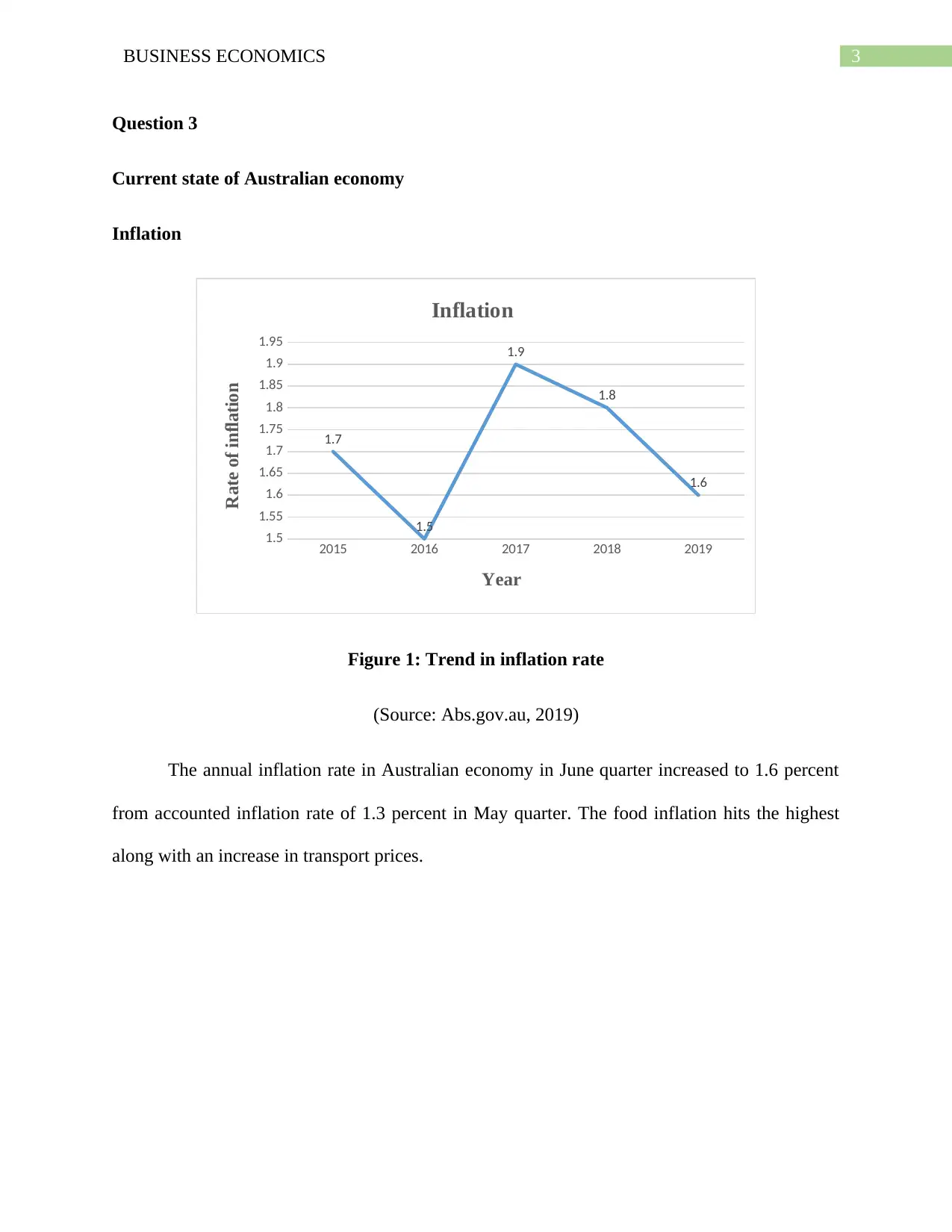
3BUSINESS ECONOMICS
Question 3
Current state of Australian economy
Inflation
2015 2016 2017 2018 2019
1.5
1.55
1.6
1.65
1.7
1.75
1.8
1.85
1.9
1.95
1.7
1.5
1.9
1.8
1.6
Inflation
Year
Rate of inflation
Figure 1: Trend in inflation rate
(Source: Abs.gov.au, 2019)
The annual inflation rate in Australian economy in June quarter increased to 1.6 percent
from accounted inflation rate of 1.3 percent in May quarter. The food inflation hits the highest
along with an increase in transport prices.
Question 3
Current state of Australian economy
Inflation
2015 2016 2017 2018 2019
1.5
1.55
1.6
1.65
1.7
1.75
1.8
1.85
1.9
1.95
1.7
1.5
1.9
1.8
1.6
Inflation
Year
Rate of inflation
Figure 1: Trend in inflation rate
(Source: Abs.gov.au, 2019)
The annual inflation rate in Australian economy in June quarter increased to 1.6 percent
from accounted inflation rate of 1.3 percent in May quarter. The food inflation hits the highest
along with an increase in transport prices.
Paraphrase This Document
Need a fresh take? Get an instant paraphrase of this document with our AI Paraphraser
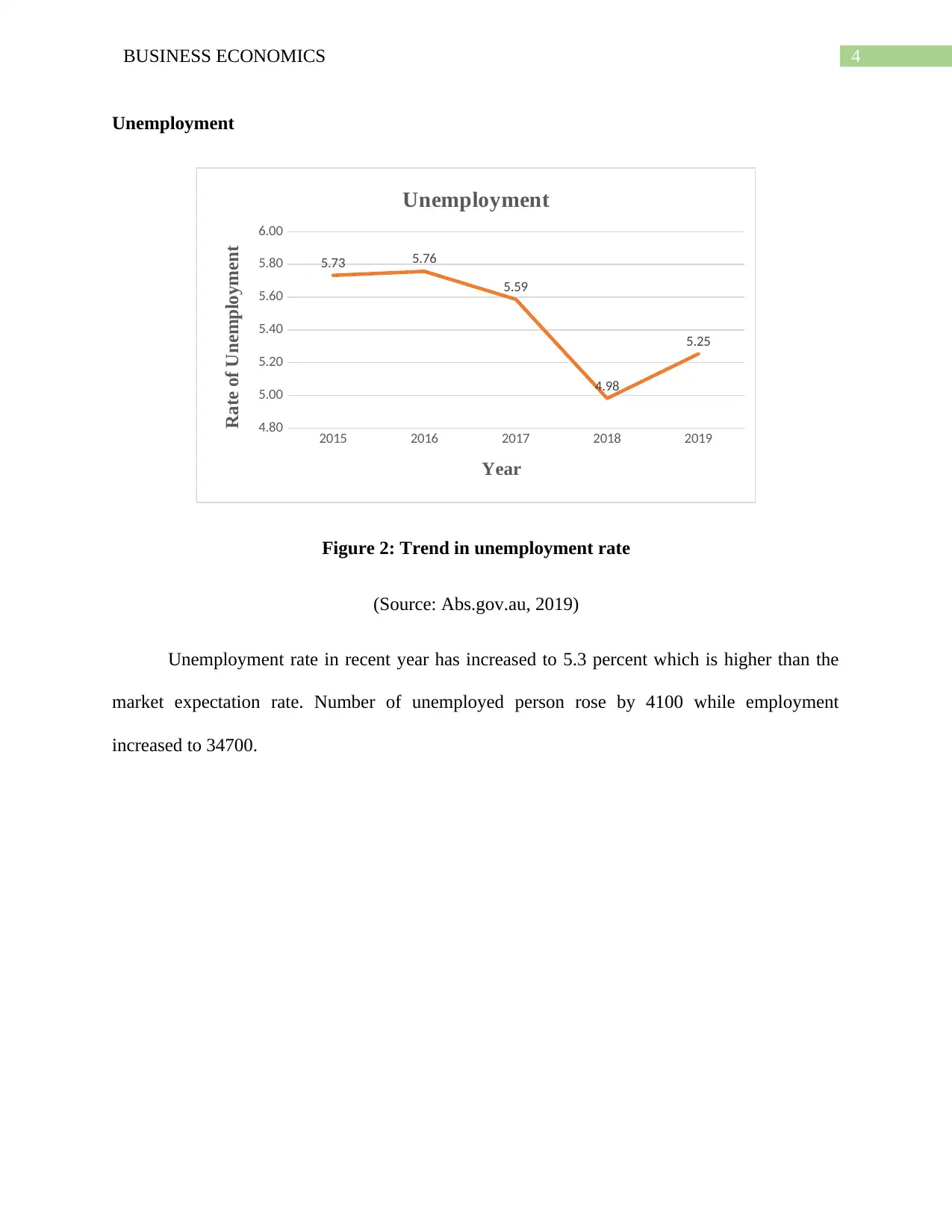
4BUSINESS ECONOMICS
Unemployment
2015 2016 2017 2018 2019
4.80
5.00
5.20
5.40
5.60
5.80
6.00
5.73 5.76
5.59
4.98
5.25
Unemployment
Year
Rate of Unemployment
Figure 2: Trend in unemployment rate
(Source: Abs.gov.au, 2019)
Unemployment rate in recent year has increased to 5.3 percent which is higher than the
market expectation rate. Number of unemployed person rose by 4100 while employment
increased to 34700.
Unemployment
2015 2016 2017 2018 2019
4.80
5.00
5.20
5.40
5.60
5.80
6.00
5.73 5.76
5.59
4.98
5.25
Unemployment
Year
Rate of Unemployment
Figure 2: Trend in unemployment rate
(Source: Abs.gov.au, 2019)
Unemployment rate in recent year has increased to 5.3 percent which is higher than the
market expectation rate. Number of unemployed person rose by 4100 while employment
increased to 34700.
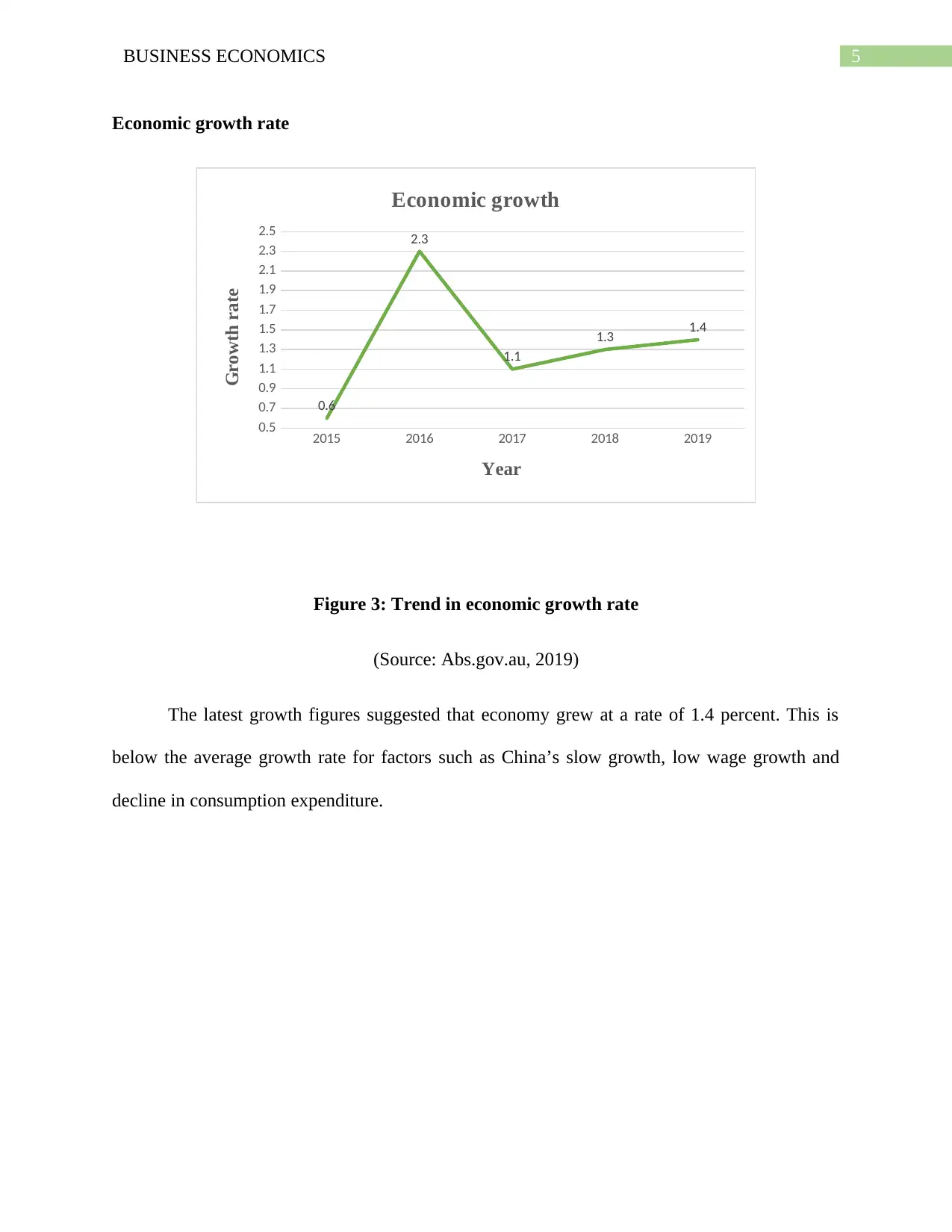
5BUSINESS ECONOMICS
Economic growth rate
2015 2016 2017 2018 2019
0.5
0.7
0.9
1.1
1.3
1.5
1.7
1.9
2.1
2.3
2.5
0.6
2.3
1.1
1.3 1.4
Economic growth
Year
Growth rate
Figure 3: Trend in economic growth rate
(Source: Abs.gov.au, 2019)
The latest growth figures suggested that economy grew at a rate of 1.4 percent. This is
below the average growth rate for factors such as China’s slow growth, low wage growth and
decline in consumption expenditure.
Economic growth rate
2015 2016 2017 2018 2019
0.5
0.7
0.9
1.1
1.3
1.5
1.7
1.9
2.1
2.3
2.5
0.6
2.3
1.1
1.3 1.4
Economic growth
Year
Growth rate
Figure 3: Trend in economic growth rate
(Source: Abs.gov.au, 2019)
The latest growth figures suggested that economy grew at a rate of 1.4 percent. This is
below the average growth rate for factors such as China’s slow growth, low wage growth and
decline in consumption expenditure.
⊘ This is a preview!⊘
Do you want full access?
Subscribe today to unlock all pages.

Trusted by 1+ million students worldwide
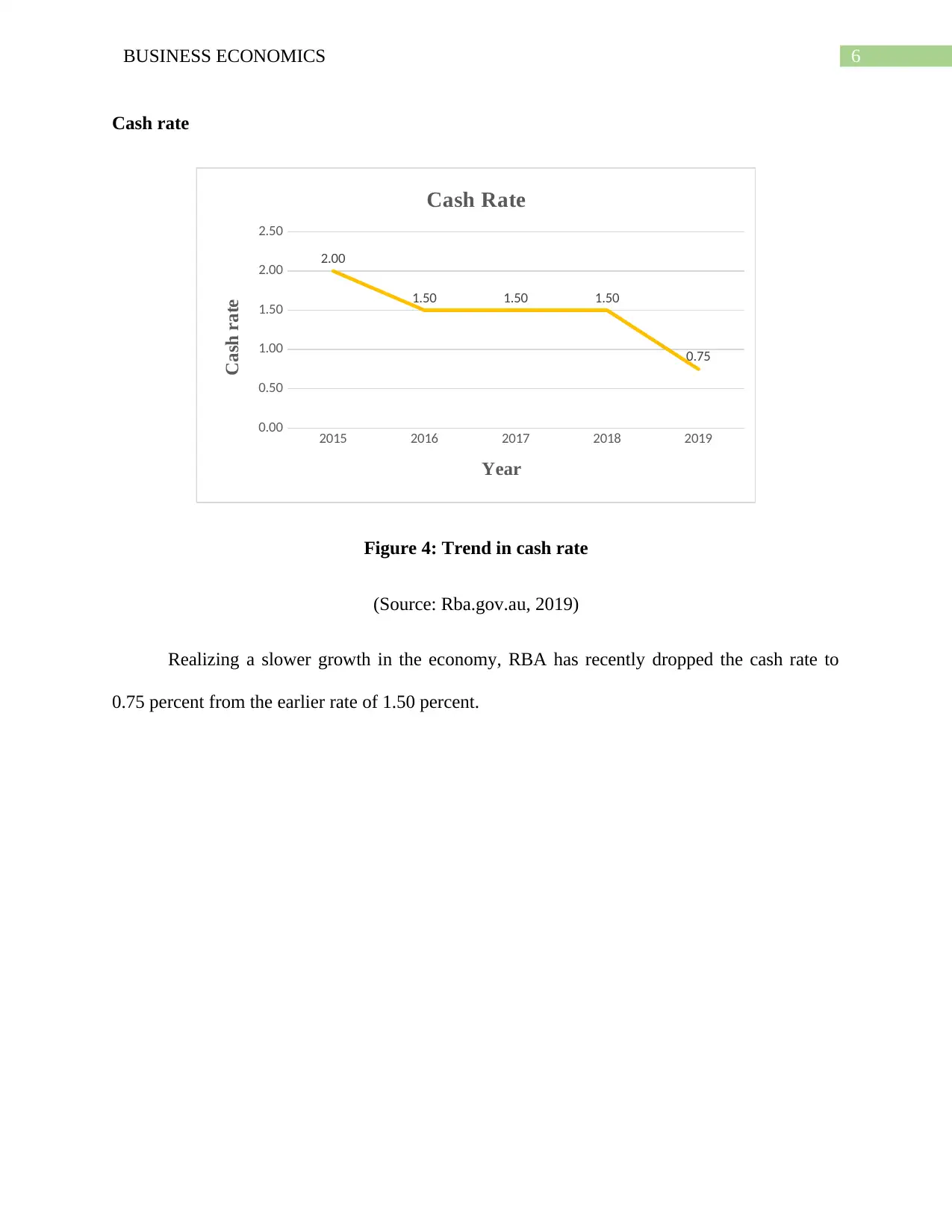
6BUSINESS ECONOMICS
Cash rate
2015 2016 2017 2018 2019
0.00
0.50
1.00
1.50
2.00
2.50
2.00
1.50 1.50 1.50
0.75
Cash Rate
Year
Cash rate
Figure 4: Trend in cash rate
(Source: Rba.gov.au, 2019)
Realizing a slower growth in the economy, RBA has recently dropped the cash rate to
0.75 percent from the earlier rate of 1.50 percent.
Cash rate
2015 2016 2017 2018 2019
0.00
0.50
1.00
1.50
2.00
2.50
2.00
1.50 1.50 1.50
0.75
Cash Rate
Year
Cash rate
Figure 4: Trend in cash rate
(Source: Rba.gov.au, 2019)
Realizing a slower growth in the economy, RBA has recently dropped the cash rate to
0.75 percent from the earlier rate of 1.50 percent.
Paraphrase This Document
Need a fresh take? Get an instant paraphrase of this document with our AI Paraphraser
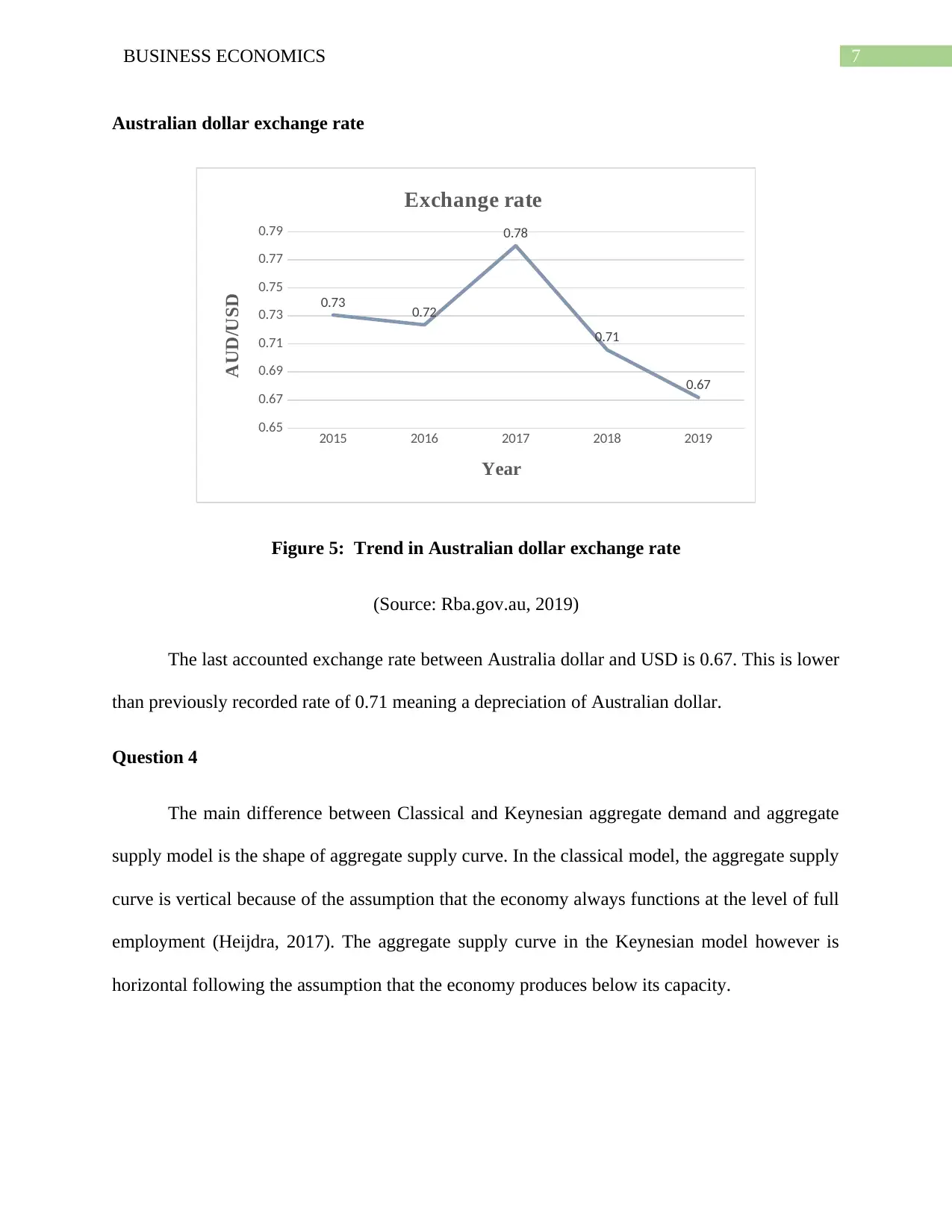
7BUSINESS ECONOMICS
Australian dollar exchange rate
2015 2016 2017 2018 2019
0.65
0.67
0.69
0.71
0.73
0.75
0.77
0.79
0.73 0.72
0.78
0.71
0.67
Exchange rate
Year
AUD/USD
Figure 5: Trend in Australian dollar exchange rate
(Source: Rba.gov.au, 2019)
The last accounted exchange rate between Australia dollar and USD is 0.67. This is lower
than previously recorded rate of 0.71 meaning a depreciation of Australian dollar.
Question 4
The main difference between Classical and Keynesian aggregate demand and aggregate
supply model is the shape of aggregate supply curve. In the classical model, the aggregate supply
curve is vertical because of the assumption that the economy always functions at the level of full
employment (Heijdra, 2017). The aggregate supply curve in the Keynesian model however is
horizontal following the assumption that the economy produces below its capacity.
Australian dollar exchange rate
2015 2016 2017 2018 2019
0.65
0.67
0.69
0.71
0.73
0.75
0.77
0.79
0.73 0.72
0.78
0.71
0.67
Exchange rate
Year
AUD/USD
Figure 5: Trend in Australian dollar exchange rate
(Source: Rba.gov.au, 2019)
The last accounted exchange rate between Australia dollar and USD is 0.67. This is lower
than previously recorded rate of 0.71 meaning a depreciation of Australian dollar.
Question 4
The main difference between Classical and Keynesian aggregate demand and aggregate
supply model is the shape of aggregate supply curve. In the classical model, the aggregate supply
curve is vertical because of the assumption that the economy always functions at the level of full
employment (Heijdra, 2017). The aggregate supply curve in the Keynesian model however is
horizontal following the assumption that the economy produces below its capacity.
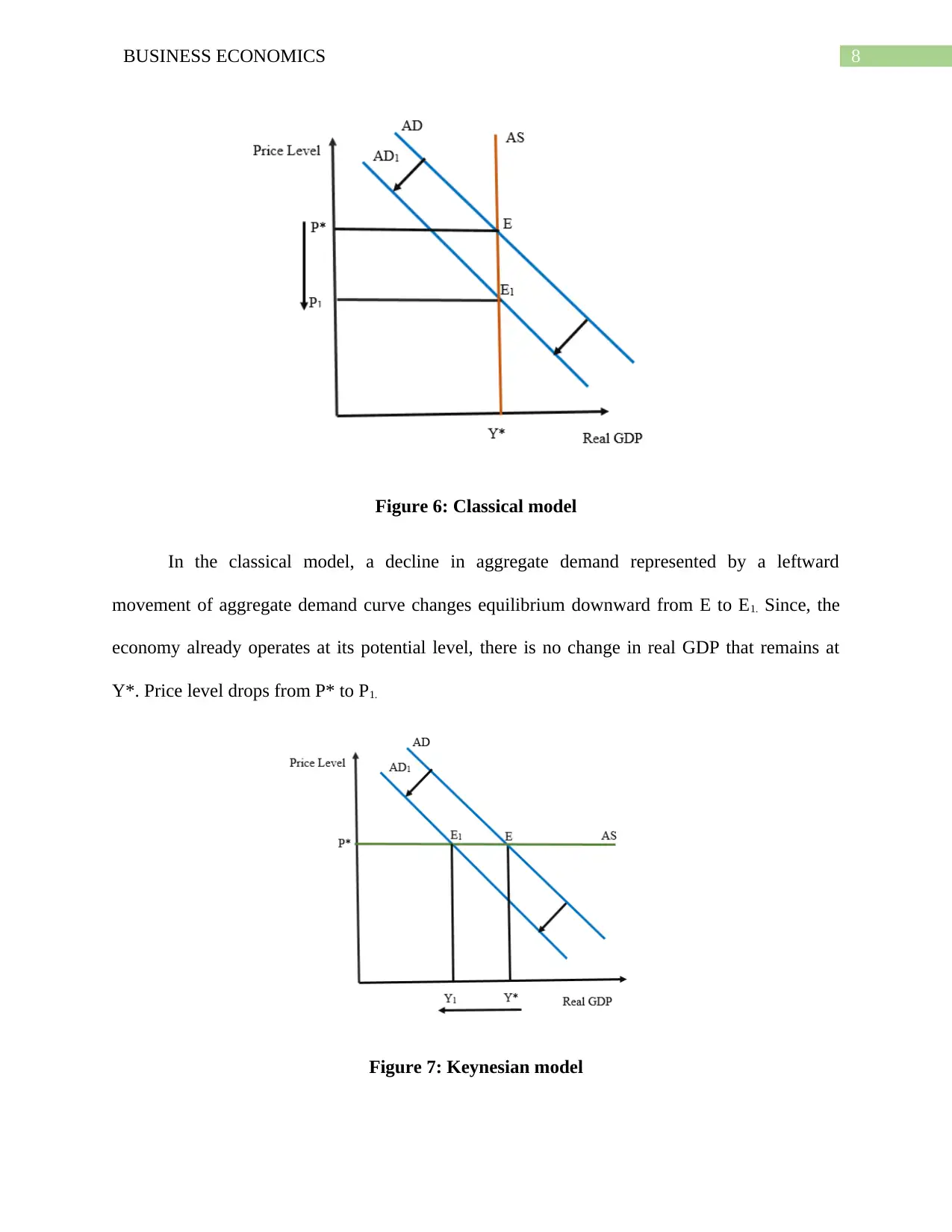
8BUSINESS ECONOMICS
Figure 6: Classical model
In the classical model, a decline in aggregate demand represented by a leftward
movement of aggregate demand curve changes equilibrium downward from E to E1. Since, the
economy already operates at its potential level, there is no change in real GDP that remains at
Y*. Price level drops from P* to P1.
Figure 7: Keynesian model
Figure 6: Classical model
In the classical model, a decline in aggregate demand represented by a leftward
movement of aggregate demand curve changes equilibrium downward from E to E1. Since, the
economy already operates at its potential level, there is no change in real GDP that remains at
Y*. Price level drops from P* to P1.
Figure 7: Keynesian model
⊘ This is a preview!⊘
Do you want full access?
Subscribe today to unlock all pages.

Trusted by 1+ million students worldwide
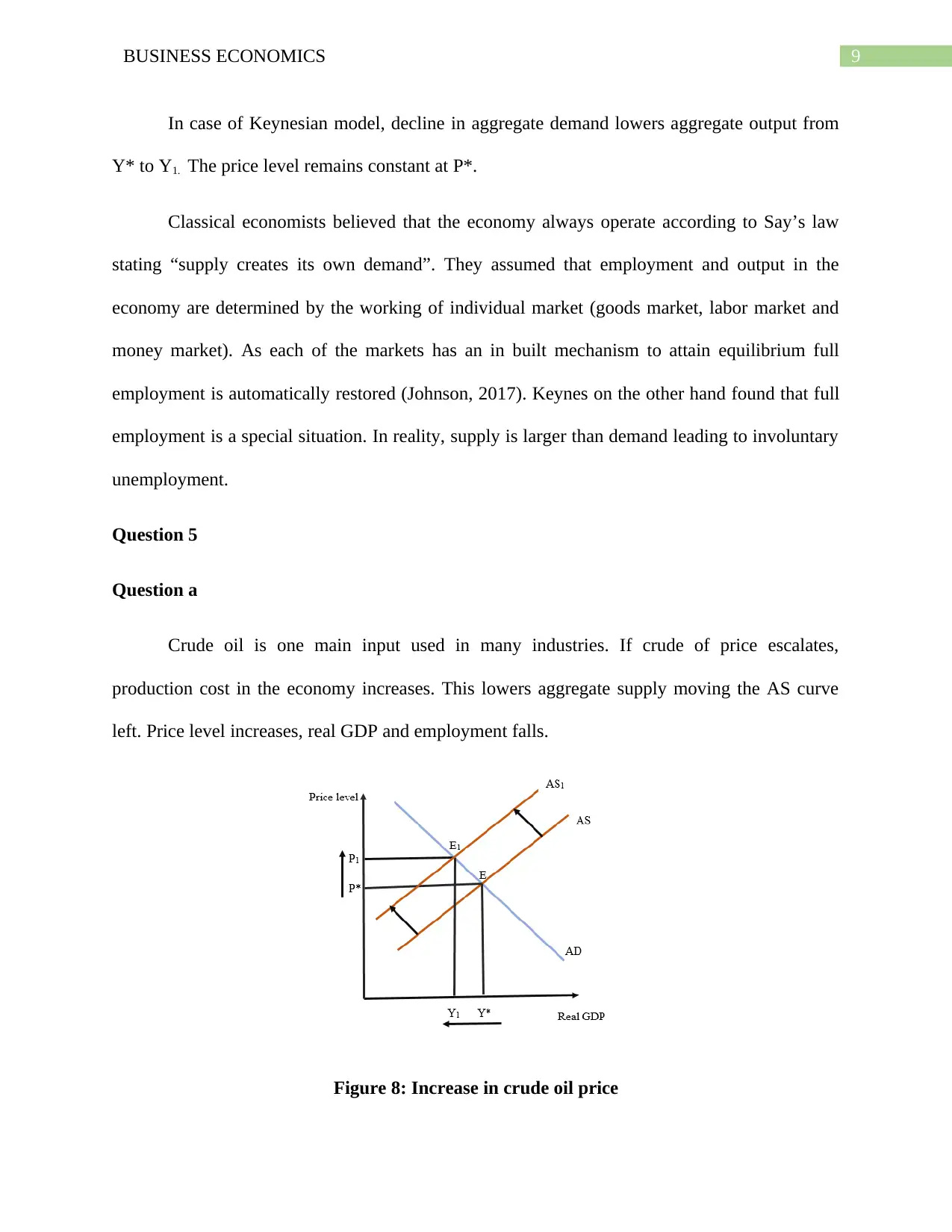
9BUSINESS ECONOMICS
In case of Keynesian model, decline in aggregate demand lowers aggregate output from
Y* to Y1. The price level remains constant at P*.
Classical economists believed that the economy always operate according to Say’s law
stating “supply creates its own demand”. They assumed that employment and output in the
economy are determined by the working of individual market (goods market, labor market and
money market). As each of the markets has an in built mechanism to attain equilibrium full
employment is automatically restored (Johnson, 2017). Keynes on the other hand found that full
employment is a special situation. In reality, supply is larger than demand leading to involuntary
unemployment.
Question 5
Question a
Crude oil is one main input used in many industries. If crude of price escalates,
production cost in the economy increases. This lowers aggregate supply moving the AS curve
left. Price level increases, real GDP and employment falls.
Figure 8: Increase in crude oil price
In case of Keynesian model, decline in aggregate demand lowers aggregate output from
Y* to Y1. The price level remains constant at P*.
Classical economists believed that the economy always operate according to Say’s law
stating “supply creates its own demand”. They assumed that employment and output in the
economy are determined by the working of individual market (goods market, labor market and
money market). As each of the markets has an in built mechanism to attain equilibrium full
employment is automatically restored (Johnson, 2017). Keynes on the other hand found that full
employment is a special situation. In reality, supply is larger than demand leading to involuntary
unemployment.
Question 5
Question a
Crude oil is one main input used in many industries. If crude of price escalates,
production cost in the economy increases. This lowers aggregate supply moving the AS curve
left. Price level increases, real GDP and employment falls.
Figure 8: Increase in crude oil price
Paraphrase This Document
Need a fresh take? Get an instant paraphrase of this document with our AI Paraphraser
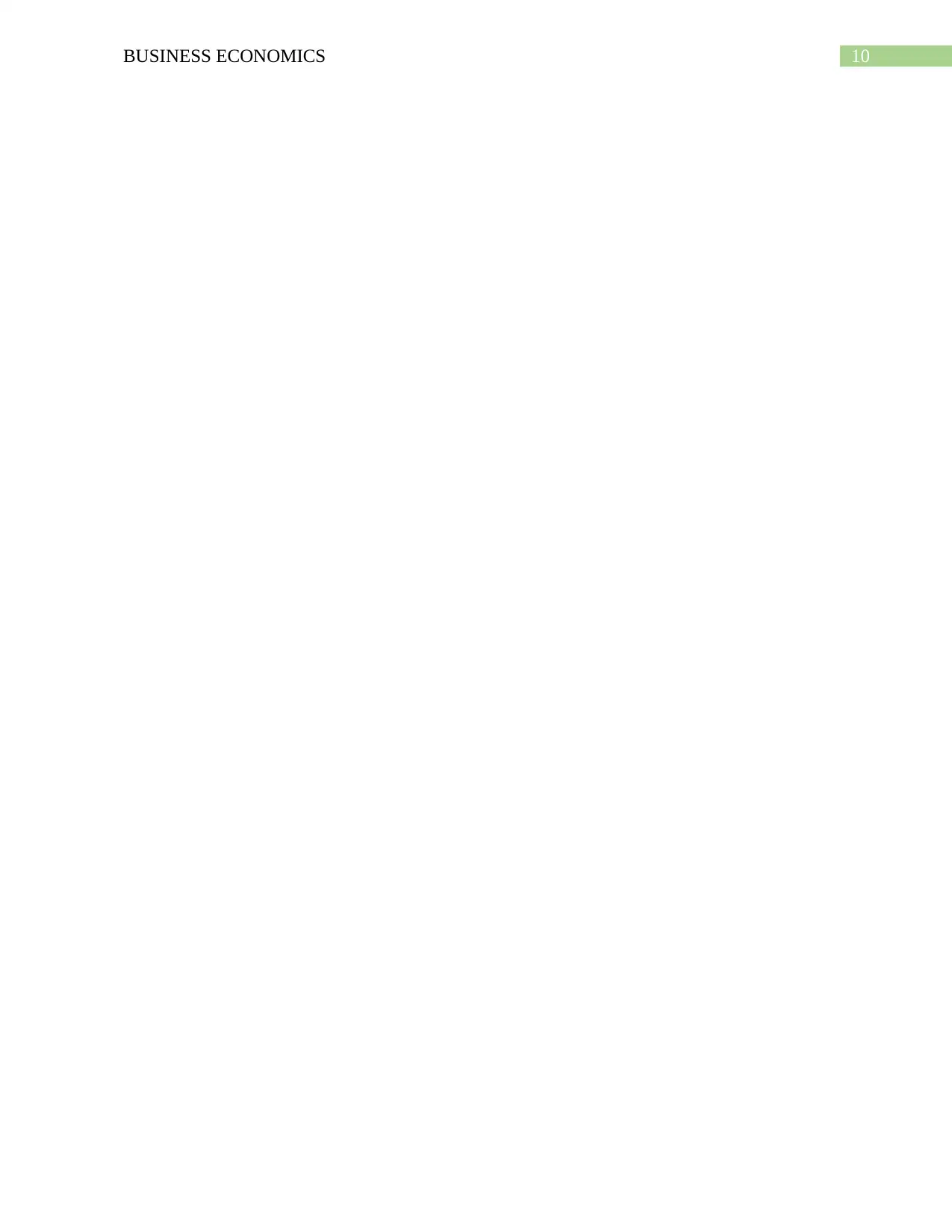
10BUSINESS ECONOMICS

11BUSINESS ECONOMICS
Question b
If government doubles the spending on welfare and aged pensions, this will increase
disposable income of household. As a result of increased income consumption increases. This
raises aggregate demand and shifts the demand curve rightward (Guilmi, Gallegati & Landini,
2017). Consequently, price level, real GDP and employment increases.
Figure 9: Increased in spending on welfare and aged pension
Question c
Depreciation of currency increases export of an economy resulting in an increase in net
export. Followed by an increase in net export, aggregate demand increases and demand curve
shifts outward. Finally, there is an increase in real GDP, employment and price level.
Question b
If government doubles the spending on welfare and aged pensions, this will increase
disposable income of household. As a result of increased income consumption increases. This
raises aggregate demand and shifts the demand curve rightward (Guilmi, Gallegati & Landini,
2017). Consequently, price level, real GDP and employment increases.
Figure 9: Increased in spending on welfare and aged pension
Question c
Depreciation of currency increases export of an economy resulting in an increase in net
export. Followed by an increase in net export, aggregate demand increases and demand curve
shifts outward. Finally, there is an increase in real GDP, employment and price level.
⊘ This is a preview!⊘
Do you want full access?
Subscribe today to unlock all pages.

Trusted by 1+ million students worldwide
1 out of 19
Related Documents
Your All-in-One AI-Powered Toolkit for Academic Success.
+13062052269
info@desklib.com
Available 24*7 on WhatsApp / Email
![[object Object]](/_next/static/media/star-bottom.7253800d.svg)
Unlock your academic potential
Copyright © 2020–2025 A2Z Services. All Rights Reserved. Developed and managed by ZUCOL.





